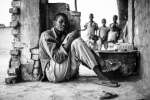UNHCR helps Congolese refugees return from Mozambique
News Stories, 12 June 2007

NAMPULA, Mozambique, June 12 (UNHCR) – The UN refugee agency has begun an airlift to repatriate refugees to the Democratic Republic of the Congo (DRC) from Mozambique.
A chartered Hawker Siddeley 748 aircraft left Nampula, near the refugee camp of Maratane in the north of Mozambique, with 58 refugees soon after dawn on Monday and repeated the mission on Tuesday with a further 54 refugees.
Because of problems in arranging landing clearance in DRC, the refugees were flown to Kigoma in Tanzania, where they were scheduled to embark Tuesday afternoon on a ship crossing Lake Tanganyika to the refugees' homeland. UNHCR had already been using the ship to repatriate Congolese refugees returning from Tanzania.
Discussions were under way to permit direct flights to DRC for about 170 additional Congolese refugees who have requested to return home from Maratane Camp.
"I am overjoyed that the registered refugees are finally able to return," said UNHCR Representative in Mozambique Victoria Akyeampong. "I hope this movement will encourage others in the camp to also register for voluntary repatriation. DRC needs her people to rebuild its economy and society."
The repatriation was organized by UNHCR and the International Organization for Migration (IOM) with the cooperation of the various governments involved. The refugees were accompanied by UNHCR and IOM staff.
The refugees, who had asked three months ago to repatriate to DRC, left Maratane by bus at about four in the morning and took off from Nampula airport after dawn. Most refugees asking to repatriate were going home to Uvira, Fizi and Baraka in the South Kivu region, with a few returning to the Katanga region.
The Congolese comprise about 3,500 out of the total refugee camp population of some 5,000 in Mozambique. Maratane, the only refugee camp in Mozambique, was opened in 2001. Most of the refugees are from the Great Lakes region.
As part of UNHCR's search for durable solutions for refugees, the office in Mozambique will continue to facilitate the voluntary repatriation of refugees wishing to return to their countries.














































